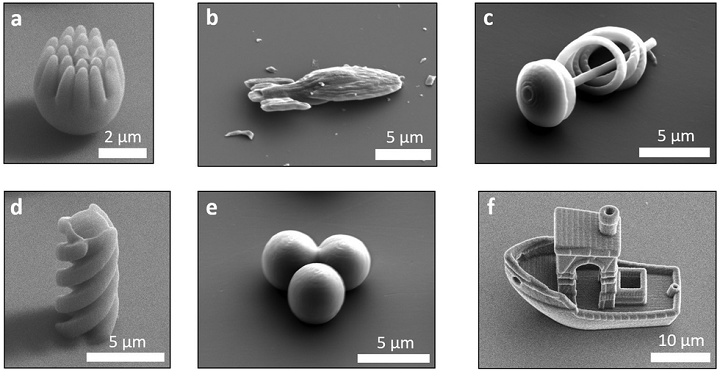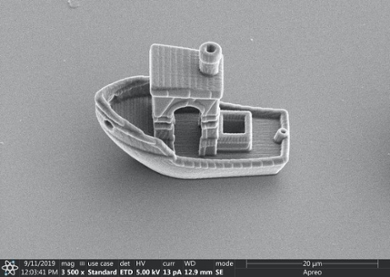We’ve seen some big 3D printed Benchy boats before, but I bet you’ve never seen one this small! A team of researchers from Leiden University in the Netherlands have published a paper, titled “Catalytically propelled 3D printed colloidal microswimmers,” in the Soft Matter journal about their investigation into biological microswimmers, such as bacteria, through the use of microscale 3D printing. Measuring just 30 microns long, their 3DBenchy is likely the tiniest boat in the world.
“Synthetic microswimmers are widely employed model systems in the studies of out-of-equilibrium phenomena. Unlike biological microswimmers which naturally occur in various shapes and forms, synthetic microswimmers have so far been limited almost exclusively to spherical shapes. Here, we exploit 3D printing to produce microswimmers with complex shapes in the colloidal size regime,” the abstract states.

Fig. 1 SEM images of various 3D printed particle shapes as obtained by two-photon polymerization. (a) A spiky sphere, (b) a starship, (c) a spiral, (d) a helix, (e) a trimer, and (f) a 3D benchy boat.
The popular 3DBenchy model provides an important benchmarking capability to use in calibrating, testing, and comparing 3D printers, in order to determine if they are able to handle intricate, complex details, like overhangs. The Leiden team’s project was focused on making synthetic microswimmers in a variety of complex shapes. These tiny objects, which use chemical reactions to propel themselves through water and other fluids, are normally just spheres, but the researchers were curious if they could produce more complicated shapes, as seen above.
The 3DBenchy model was chosen because the researchers were testing out a unique 3D printing process, called two-photon polymerization (2PP), and wanted to see if they were able to print a teeny microscale boat with a high level of detail. 2PP uses a laser to carve out complex patterns and shapes into a material that reacts to light.
“2PP has been established as a very powerful tool to 3D print microstructures with a great deal of flexibility in terms of shape and symmetry and allows the formation of structures with sub-micron resolution.28–31 Moreover, in addition to complex shape diversity, 3D-printing also provides freedom in terms of active patch location as the user can decide how a particle is oriented relative to the substrate on which it is printed and hence the location of the active patch during sputter coating, ultimately allowing additional control over the resulting active motion.,” the researchers wrote in their paper.
“The potential of 2PP to create microswimmers with a wide range of geometries is immense, allowing the production of particles with almost any desired shape.”
As you can see in the scanning electron microscope image above, the researchers were able to print an extremely detailed microscale 3DBenchy on their Nanoscribe Photonic Professional system. Even though this benchmark boat model is just one third the thickness of a human hair, it features a chimney, open cabin, and some tiny portholes as well. One face of the 3DBenchy is platinum-coated, which reacts with the surrounding fluid by producing bubbles which move the boat forward. However, this was not the most efficient shape the team created.
The researchers also 3D printed microswimmers in helices, spiky balls, spirals, and groups of three spheres, each of which also featured an end coated in platinum. The spiral and helix shapes performed the best, moving along in a corkscrew motion.

Fig. 2 A schematic of the method used to prepare 3D-printed colloidal microswimmers. (a) CAD drawing of the particle design, (b) two-photo polymerisation setup in dip mode where the objective is submerged into the photoresist, (c) SEM image of the 3D printed particle array after development, (d) sputter coating with Pt/Pd, (e) detachment of particles from substrate in water by ultrasonication, (f) active motion in a hydrogen peroxide solution.
“We establish the flexibility of 3D printing by two-photon polymerisation to produce particles smaller than 10 microns with a high-degree of shape complexity. We further demonstrate that 3D printing allows control over the location of the active site through orienting the particles in different directions during printing. We verify that particles behave colloidally by imaging their motion in the passive and active states and by investigating their mean square displacement,” the researchers wrote. “In addition, we find that particles exhibit shape-dependant behavior, thereby demonstrating the potential of our method to launch a wide-range of in-depth studies into shape-dependent active motion and behaviour.”
(Sources: New Atlas, Leiden University)
Subscribe to Our Email Newsletter
Stay up-to-date on all the latest news from the 3D printing industry and receive information and offers from third party vendors.
You May Also Like
Gorilla Sports GE’s First 3D Printed Titanium Cast
How do you help a gorilla with a broken arm? Sounds like the start of a bad joke a zookeeper might tell, but it’s an actual dilemma recently faced by...
Nylon 3D Printed Parts Made More Functional with Coatings & Colors
Parts 3D printed from polyamide (PA, Nylon) 12 using powder bed fusion (PBF) are a mainstay in the additive manufacturing (AM) industry. While post-finishing processes have improved the porosity of...
$25M to Back Sintavia’s Largest Expansion of Metal 3D Printing Capacity Since 2019
Sintavia, the digital manufacturing company specializing in mission-critical parts for strategic sectors, announced a $25 million investment to increase its production capacity, the largest expansion to its operations since 2019....
Velo3D Initiates Public Offering in a Bid to Strengthen Financial Foundations and Drive Future Growth
Velo3D (NYSE: VLD) has been among a number of publicly traded 3D printing firms that have attempted to weather the current macroeconomic climate. After posting a challenging financial report for 2023,...
































